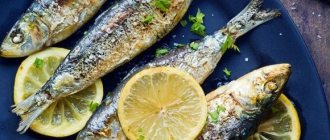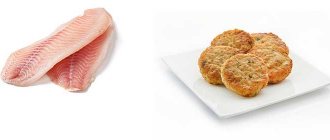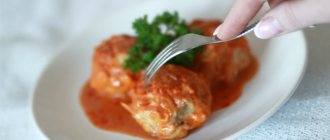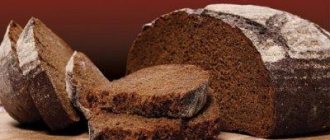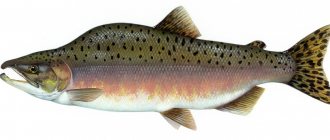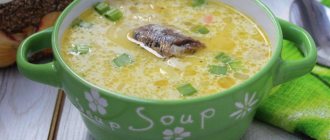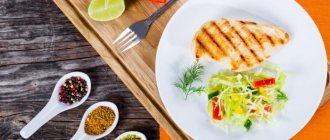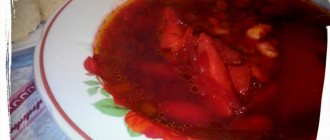Fish and meat protein
Most types of river fish contain fewer calories than lean meat, while their protein is of good quality and amino acids are absorbed much faster. At the same time, you ate a large fried piece of fish, you feel full and satisfied, but you consumed many times fewer calories. That's the advantage.
Fish protein contains little connective tissue in the form of collagen, which, when digested, turns into glutin. When cooked, these tissues lose strength and are absorbed by the body almost 100%, in contrast to meat protein, which is broken down by less than 90%.
Calorie content of notatenia fish fried in flour. Chemical composition and nutritional value
Most types of river fish contain fewer calories than lean meat, while their protein is of good quality and amino acids are absorbed much faster. At the same time, you ate a large fried piece of fish, you feel full and satisfied, but you consumed many times fewer calories. That's the advantage.
Fish protein contains little connective tissue in the form of collagen, which, when digested, turns into glutin. When cooked, these tissues lose strength and are absorbed by the body almost 100%, in contrast to meat protein, which is broken down by less than 90%.
What are the benefits of fish
Residents of coastal countries, where the share of fish products in the diet is traditionally high, know firsthand about the undoubted benefits of seafood. Thus, among the Japanese, Finns, and Danes, fish forms the basis of their national cuisine.
First courses, second courses, and all kinds of salads are prepared from this healthy product.
The Japanese, famous long-livers, believe that such a nutritional system not only prevents them from gaining extra pounds, but also prolongs life itself.
Fish is a natural source of protein. At the same time, it is low in calories. The meat of sea and river abodes is valuable for its content of vitamins (A, D, group B). It is also rich in microelements important for health (iodine, zinc, calcium, iron, phosphorus, selenium, magnesium).
Fish oil, which was given to all children in kindergartens in the USSR in the 70s of the last century, has a high content of Omega-3 polyunsaturated fatty acids. The most valuable are docosahexaenoic (DHA) and eicosapentaenoic (EPA) acids. The human body can produce some EPA and DHA from parent n-3 alpha-linolenic acid fats.
By regularly consuming fatty fish, you will bring undoubted benefits to your body.
| For which organs and systems | What's the use |
| For heart. | Omega-3 acids and vitamin B 12 improve venous and arterial blood flow, which helps prevent myocardial infarction. An average portion of a fish dish provides the daily requirement of B12 for an adult. |
| For the brain. | B vitamins (thiamine, riboflavin, pyridoxine), as well as Omega-3 fats, prevent the development of depression, facilitate the process of cognition and improve memory. A 100-gram serving of fatty fish will provide about 10% of the daily value of these vitamins. |
| For the skeletal system. | Fish acts as a source of vitamin D, which helps strengthen bone tissue. In addition, Omega-3 acids improve joint mobility and prevent arthritis. |
| For skin, nails and hair. | With regular consumption of fish dishes rich in vitamin A, hair becomes strong and shiny. Nails stop peeling and breaking. The skin gets a healthy look and moisture. |
| For the whole body as a whole. | The immune system is strengthened, metabolism is improved, and the risk of cancer and diabetes is reduced. |
Fish is especially recommended for expectant mothers. Fatty acids are essential building materials for the fetal brain and support for the mother's body. But no matter how tasty and healthy fatty varieties are - salmon, mackerel, trout (which cannot be said about capelin), pregnant women should not abuse them and it is better to limit themselves to two such meals a week.
Fatty and low-fat varieties
Fish is an excellent dietary product. The calorie content of fish depends on its variety, and sea fish is usually higher in calories than river fish. Based on fat content, the product is usually classified into fatty varieties (from 8 to 30% fat), moderately fatty (4–8%) and low-fat (up to 4%).
So, fatty varieties include:
- trout;
- mackerel;
- herring;
- salmon;
- sea bass;
- salmon;
- sardine;
- sturgeon;
- cod (liver).
Moderately fatty fish: chum salmon, pink salmon, herring, sea bass, horse mackerel, tuna, capelin, catfish, lean herring, carp, catfish, crucian carp. So, in carp there are about 135 kcal per 100 grams. Low-fat varieties include the following representatives: pollock, hake, pike, pike perch, carp, bream, carp, blue whiting, pollock, mullet, flounder, navaga and cod (its meat).
It is very important how the fish is cooked. During the frying process, it becomes saturated with fat and the number of kcal increases by 30–50 for every 100 g. Therefore, it is better to fry low-fat varieties. To determine the calorie content of fried fish, add the calorie content of the fish to the calorie content of the frying oil. If you use batter, add 70–80 kcal when counting (this is flour and eggs).
Fried fish is a delicious dish. But when frying, few vitamins and nutrients are retained in the composition. But with oil, carcinogens and excess fat are added. It is difficult to find something healthier than stewed, baked in foil or steamed fish.
How to fry river fish
The best varieties for frying are carp, carp, and bream; the dish from them will turn out juicy, regardless of the cooking method.
First you need to clean the fish from scales, usually this is done with a special knife. Next, wash off the remaining scales with running water, gut the fish, cut off the fins, remove the gills or completely cut off the head, and rinse again.
If you don’t like to take the bones out of the fish, there is a little trick - make transverse cuts on the back, so the small bones, of which there are a lot in this part, will not be felt after frying, they will steam and become softer.
Rub the fish with salt and pepper and wait 30-50 minutes. Roll in flour and place in a preheated frying pan with plenty of vegetable oil; the fish will taste better if it is unrefined. Fry on both sides until golden brown. Delicious fried fish is ready. Bon appetit!
Baked pink salmon
Before baking, it is recommended to soak pink salmon in some sauce with spices and send it to the oven, wrapped in foil. Then the finished dish will be tender and juicy.
It is possible to significantly reduce the calorie content of pink salmon baked in the oven if you use regular kefir instead of cream and mayonnaise. For 1 kg of fillet you will need 100 g of kefir, lemon, salt, ground pepper and other spices.
Rub the pieces with spices and salt, pour kefir and lemon juice and marinate for at least half an hour. Cover a baking sheet with foil, place thin lemon slices on it, and fish on top. Place potato mugs between the pieces. Pour marinade over everything, cover with foil and bake for 40 minutes at 220°C. For beautiful browning, remove the top layer of foil five minutes before cooking.
Composition and beneficial properties
Crucian carp is a truly tasty and valuable product for the human body. It contains useful substances and elements that have a positive effect on health.
He is rich:
- Vitamin A. Dissolves fat and helps keep your figure in shape.
- Vitamins of group B. Improve brain activity and memory.
- Vitamin C. Protects the body from premature aging, depression and aging.
- Vitamin E. Helps maintain vision and protects the body from various infections.
In addition, the product is rich in micro- and macroelements:
- Iodine. Normalizes the functioning of the thyroid gland.
- Calcium, phosphorus and fluorine. Strengthen bones, stimulate hair and nail growth, and also promote the formation of tooth enamel.
The freshwater product is especially useful for young children, diabetics, and women during pregnancy or lactation. It improves appetite, lowers blood sugar and improves immunity.
Advantages and disadvantages of fried fish and how best to cook it
If you take a certain variety and cook it in two ways, for example, steamed and fried, then in the first case the calorie content will be lower than in the second. But if you are struggling with excess weight and you prefer fried fish rather than boiled fish, then don’t look at the calories, regardless of them, such a delicacy helps burn fat and helps you become slimmer. During frying, high heat treatment occurs, which destroys all possible parasites present in river fish, so this is not only a tasty, but also a safe method of cooking.
You need to be able to properly cook fish in order to preserve beneficial vitamins and microelements in it. The most useful in terms of the amount of substances will be fresh fish. During heat treatment, beneficial substances disintegrate, so in fried food there will be fewer of them than in boiled food. Fish is a unique product, despite the widespread belief that everything fried is harmful to the body, because it has a lot of calories, 100 grams on average 140 Kcal, and this is due to the vegetable oils used in cooking.
More on the same topic:
2 comments
- angel writes, The calorie content of fried fish depends not only on the oil in which it is fried, but also on the type of fish. After all, the calorie content of, for example, fried tuna will be significantly higher than, say, fried hake. Under equal frying conditions.
- Karina Writes,
Naturally, how many calories fish contains depends entirely on the method of its preparation. And it is natural that the calorie content of fried fish will be much higher than boiled or steamed. After all, when frying, vegetable oil is used, pieces of fish are dumped in flour, which adds up to calories. Yes, the beneficial properties of fried fish will be less, since frying fish reduces the content of substances beneficial to the human body in it. But with all this, fried fish is the most delicious.
How many calories are in different types of fried fish?
The energy value of this dish is primarily determined by how many calories are in the key raw product. Thus, pollock and cod are among the most dietary types of fish, and after heat treatment they will still be lighter than a fried salmon steak. Red sea fish are usually a little fattier and therefore higher in calories than white river fish. For this reason, they are often recommended to be steamed or baked to avoid adding “weight”.
Also, to decide the question of how many calories are in fried fish, it is worth considering the specific recipe. Basically, the product is prepared in oil, which is absorbed very well, especially into soft fillets of pollock, pangasius, and haddock. How many calories the fish will gain depends on the volume and type of oil. Creamy is a little lighter - 771 kcal per 100 g, but vegetable has more than 800 kcal, so you should be careful with it.
If you want dietary fried fish, cook it in a dry grill pan or only lightly grease the bottom with oil: do not let the product float in fat.
Various additives also significantly add calories to fried fish: breading in flour or breadcrumbs is even more so than egg-milk batter. And if you sprinkle the product with cheese when frying, not only the number of calories will increase, but also the volume of fat. Approximate calorie values for different types of fish fried without additives in vegetable oil:
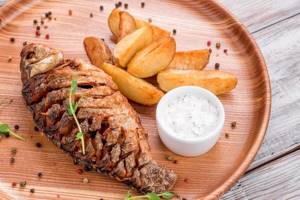
- Pollock – 137 kcal.
- Crucian carp – 121 kcal.
- Carp – 197 kcal.
- Pike – 127 kcal.
- Flounder – 91 kcal.
- Cod – 60 kcal.
The approximate calorie content of fried fish without additives ranges from 60-200 kcal , depending on the type of product. If you prepare the product by rolling it in flour, the indicator will increase by 30-50 kcal: the figure is determined by the amount of breading.
Fish in dough, fried: calorie content per 100 grams
Most types of river fish contain fewer calories than lean meat, while their protein is of good quality and amino acids are absorbed much faster.
At the same time, you ate a large fried piece of fish, you feel full and satisfied, but you consumed many times fewer calories. That's the advantage. Fish protein contains little connective tissue in the form of collagen, which, when digested, turns into glutin. When cooked, these tissues lose strength and are absorbed by the body almost 100%, in contrast to meat protein, which is broken down by less than 90%.
Baked pink salmon
Before baking, it is recommended to soak pink salmon in some sauce with spices and send it to the oven, wrapped in foil. Then the finished dish will be tender and juicy.
It is possible to significantly reduce the calorie content of pink salmon baked in the oven if you use regular kefir instead of cream and mayonnaise. For 1 kg of fillet you will need 100 g of kefir, lemon, salt, ground pepper and other spices.
Rub the pieces with spices and salt, pour kefir and lemon juice and marinate for at least half an hour. Cover a baking sheet with foil, place thin lemon slices on it, and fish on top. Place potato mugs between the pieces. Pour marinade over everything, cover with foil and bake for 40 minutes at 220°C. For beautiful browning, remove the top layer of foil five minutes before cooking.
Advantages and disadvantages of fried fish and how best to cook it
If you take a certain variety and cook it in two ways, for example, steamed and fried, then in the first case the calorie content will be lower than in the second.
But if you are struggling with excess weight and you prefer fried fish rather than boiled fish, then don’t look at the calories, regardless of them, such a delicacy helps burn fat and helps you become slimmer.
During frying, high heat treatment occurs, which destroys all possible parasites present in river fish, so this is not only a tasty, but also a safe method of cooking.
During heat treatment, beneficial substances disintegrate, so in fried food there will be fewer of them than in boiled food.
Fish is a unique product, despite the widespread belief that everything fried is harmful to the body, because it has a lot of calories, 100 grams on average 140 Kcal, and this is due to the vegetable oils used in cooking.
How to fry river fish
The best varieties for frying are carp, carp, and bream; the dish from them will turn out juicy, regardless of the cooking method.
First you need to clean the fish from scales, usually this is done with a special knife. Next, wash off the remaining scales with running water, gut the fish, cut off the fins, remove the gills or completely cut off the head, and rinse again.
If you don’t like to take the bones out of the fish, there is a little trick - make transverse cuts on the back, so the small bones, of which there are a lot in this part, will not be felt after frying, they will steam and become softer.
Rub the fish with salt and pepper and wait 30-50 minutes. Roll in flour and place in a preheated frying pan with plenty of vegetable oil; the fish will taste better if it is unrefined. Fry on both sides until golden brown. Delicious fried fish is ready. Bon appetit!
How many calories are in different types of fried fish?
The energy value of this dish is primarily determined by how many calories are in the key raw product.
Thus, pollock and cod are among the most dietary types of fish, and after heat treatment they will still be lighter than a fried salmon steak.
Red sea fish are usually a little fattier and therefore higher in calories than white river fish. For this reason, they are often recommended to be steamed or baked to avoid adding “weight”.
Basically, the product is prepared in oil, which is absorbed very well, especially into soft fillets of pollock, pangasius, and haddock. How many calories the fish will gain depends on the volume and type of oil.
Creamy is a little lighter - 771 kcal per 100 g, but vegetable has more than 800 kcal, so you should be careful with it.
If you want dietary fried fish, cook it in a dry grill pan or only lightly grease the bottom with oil: do not let the product float in fat.
Various additives also significantly add calories to fried fish: breading in flour or breadcrumbs is even more so than egg-milk batter. And if you sprinkle the product with cheese when frying, not only the number of calories will increase, but also the volume of fat. Approximate calorie values for different types of fish fried without additives in vegetable oil:
- Pollock – 137 kcal.
- Crucian carp – 121 kcal.
- Carp – 197 kcal.
- Pike – 127 kcal.
- Flounder – 91 kcal.
- Cod – 60 kcal.
The approximate calorie content of fried fish without additives ranges from 60-200 kcal , depending on the type of product. If you prepare the product by rolling it in flour, the indicator will increase by 30-50 kcal: the figure is determined by the amount of breading.
Steamed fish, how many calories does it have?
This is another way to cook fish. But how many calories are in steamed fish? To do this, you again need to consider each type of fish separately.
For example, salmon contains 197 kcal, proteins – 19.3 g, fats – 14 g. This is an indispensable product in the treatment of certain skin diseases. This fish also helps strengthen muscle tissue. It is recommended to consume salmon prepared in this way no more than 2 times a week.
How many calories are in sea fish? It contains 79 kcal, protein – 17.53 g, fat – 1 g. This is a light and healthy product. Most often it is recommended for people who have digestive problems.
Flounder is also steamed. Its calorie content is 90 kcal, proteins – 16.1 g, fats – 2.7 g, and carbohydrates – 0.2 g. This fish is ideal for dietary nutrition. It contains low levels of fat and is very easily absorbed by the body.
Steamed hake contains 107.35 kcal, protein – 19.16 g, fat – 5.39 g.
Both boiled and steamed fish retain the most beneficial substances contained in it. This type of preparation is considered one of the best, as it is easily digestible and after the processing process does not accumulate a large amount of fat, as happens during frying.
How to calculate the calorie content of fried fish?
Turning to open sources for ready-made data every time is difficult. Moreover, no one will give you the exact values: they depend on your recipe. In order to roughly understand how many calories are in fish fried in flour, batter, cheese and other additives, you should remember the principles of counting:
- The vegetable or butter that you use for frying is not completely absorbed into the fish, and part of it also burns out - those areas where the fish pieces do not lie. Therefore, experts advise adding approximately 50% of the oil used to the calorie content of the fish.
- The calorie content of the fish itself is calculated based on the raw product. If you fry a 100 g piece, and during heat treatment it decreases in weight to 80 g, its calorie content still remains the same as 100 g.
- For complex dishes, the calorie content of each product is added together and the resulting number is divided by the total weight of the components and multiplied by 100 to obtain the energy value for a 100-gram serving.
: Hot Smoked Squid Calories
How many calories in is more processed than other varieties, and therefore has a high calorie content. Boiling is considered the optimal way to prepare fish; it is in this form that the dish retains all the vitamins and has a low fat content.
How many calories are in boiled fish? The least amount is found in cod - 78, in pollock - a little more - 79, in burbot - 92, hake - 95, pike perch - 97, pike - 98. Then come flounder - 103, catfish - 114, bream - 124. The highest calorie content remains fatty varieties: sturgeon – 179, mackerel – 211, halibut – 216 and others.
The calorie content of dried fish is high; in addition, when processed, the dish loses its beneficial qualities. Therefore, you should eat more boiled fish and vegetables.
We looked at the calorie content of smoked fish, dried, raw, dried and boiled. This indicator largely depends on the method of preparing the fish. But still lose weight
Calorie content of fish:
120 kcal* * average value per 100 grams, depends on the type of fish and cooking method
Fish is considered an indispensable product for dietary nutrition. Thanks to the beneficial properties of the product, the body is saturated with all beneficial nutrients. When losing weight, you should pay attention to less fatty varieties.
The benefits of fish
What are the benefits of fish and seafood, you can ask the Japanese, for whom seafood is not just ordinary food, but a national cuisine. The Japanese believe that such a nutritional system not only prevents you from gaining extra pounds, but also prolongs life. That's why they live so long.
The first undoubted advantage of fish as a source of protein is its relatively low calorie content. It should be noted that the fish itself, depending on the calorie content and variety, is divided into fatty and dietary types.
The number of calories in fish also varies depending on the cooking method.
It goes without saying that if you steam or boil it, it will be less high in calories, and fried, since vegetable oil is used for frying, it will be more high in calories.
As for fatty varieties, fish oil itself is much healthier than animal fat. The most important thing is that fish oil contains a lot of omega-3 fatty acids.
In countries where fish cuisine predominates, the mortality rate from this type of disease is much lower.
Unfortunately, the human body cannot create these acids on its own, and therefore it is necessary to organize the supply of these extremely useful substances with food or special nutritional supplements.
And the natural mechanism of entry into the human body is the consumption of fatty fish, such as salmon, sardines, tuna, mackerel.
These acids are also found in other types of fish, but in smaller quantities.
It is also indispensable in dietary nutrition, as it is an excellent natural source of high-quality protein, low in fat and calorie content. In addition, its meat is rich in vitamins, minerals and trace elements, for example, calcium, phosphorus, iodine, zinc, iron, magnesium, etc.
Source: https://rayda.su/zdorovoe-pitanie/som-zharenyj-kalorijnost.html
How to calculate the calorie content of fried fish?

Turning to open sources for ready-made data every time is difficult. Moreover, no one will give you the exact values: they depend on your recipe. In order to roughly understand how many calories are in fish fried in flour, batter, cheese and other additives, you should remember the principles of counting:
- The vegetable or butter that you use for frying is not completely absorbed into the fish, and part of it also burns out - those areas where the fish pieces do not lie. Therefore, experts advise adding approximately 50% of the oil used to the calorie content of the fish.
- The calorie content of the fish itself is calculated based on the raw product. If you fry a 100 g piece, and during heat treatment it decreases in weight to 80 g, its calorie content still remains the same as 100 g.
- For complex dishes, the calorie content of each product is added together and the resulting number is divided by the total weight of the components and multiplied by 100 to obtain the energy value for a 100-gram serving.
Recipe? Recipe!
How to cook it? Yes, quite simple. For example, here is a simple recipe:
Products:
- one kilogram of fish
- 150-200 grams of vegetable oil
- 50-120 grams of butter
- 100 grams of flour
- salt, to taste
For frying, it is best to choose medium-sized and fatty fish. We clean it, gut it, cut off the heads and fins. Salt and let stand for 15-20 minutes. Before frying, you need to roll the fish carcasses in flour. Take a frying pan, heat it well, pour in the vegetable oil and add butter, in an amount sufficient for frying. Fish carcasses should be laid loosely in a frying pan and fried until cooked on both sides. For better roasting, cover the frying pan with a lid for 15-20 minutes and keep it on low heat.
The benefits of fish
What are the benefits of fish and seafood, you can ask the Japanese, for whom seafood is not just ordinary food, but a national cuisine. The Japanese believe that such a nutritional system not only prevents you from gaining extra pounds, but also prolongs life. That's why they live so long.
The first undoubted advantage of fish as a source of protein is its relatively low calorie content. It should be noted that the fish itself, depending on the calorie content and variety, is divided into fatty and dietary types. The number of calories in fish also varies depending on the cooking method. It goes without saying that if you steam or boil it, it will be less high in calories, and fried, since vegetable oil is used for frying, it will be more high in calories.
As for fatty varieties, fish oil itself is much healthier than animal fat. The most important thing is that fish oil contains a lot of omega-3 fatty acids. It is worth mentioning such as eicosapentaenoic and docosahexaenoic acid. What is their usefulness? It has long been noted that these acids tend to reduce the risk of cardiovascular diseases. In countries where fish cuisine predominates, the mortality rate from this type of disease is much lower.
Unfortunately, the human body cannot create these acids on its own, and therefore it is necessary to organize the supply of these extremely useful substances with food or special nutritional supplements. And the natural mechanism of entry into the human body is the consumption of fatty fish, such as salmon, sardines, tuna, mackerel. These acids are also found in other types of fish, but in smaller quantities.
It is also indispensable in dietary nutrition, as it is an excellent natural source of high-quality protein, low in fat and calorie content. In addition, its meat is rich in vitamins, minerals and trace elements, for example, calcium, phosphorus, iodine, zinc, iron, magnesium, etc.
In addition, fish is irreplaceable for those who would not mind losing extra pounds.
Classification of fish used for food
Dishes prepared from fish occupy a significant place in the national Russian and Belarusian cuisines. All existing types of fish can be divided into 3 large groups:
- fish having white meat;
- fish having red meat;
- fish with meat with a high degree of fat content.
Important! Fish with white meat is considered the most edible and has excellent taste, and fish with red meat is the most nutritious product.
In addition to this classification, fish are divided into several groups depending on their habitat:
- freshwater fish;
- migratory fish;
- brackish water fish;
- marine;
- oceanic.
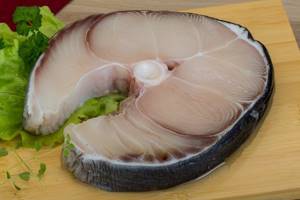
Fish with white meat
Freshwater fish species live in fresh water throughout their entire life. Reproduction of such fish also occurs in fresh water. This type of fish includes carp, bream, pike, catfish, sterlet, etc.
The group of migratory fish includes salmon and sturgeon. These fish species live in sea water and breed in fresh water. Sea and ocean fish constantly live in the salty water of the seas or oceans. Reproduction of fish belonging to these 2 groups is also carried out in sea and ocean water. These 2 groups of fish include tuna, anchovy, cod, flounder, etc.
Composition of fish
To begin with, it should be said that the calorie content of fish is low, but the chemical composition varies. The quantitative and qualitative characteristics of fish depend on the habitat of the fish and its species.
Despite the low calorie content of fish, it contains a lot of proteins, but their content depends on the specific type of fish. Inhabitants of seas, rivers and lakes can be classified according to the protein content in their meat.
- Low protein. There are few such types of fish. These include sablefish.
- Medium protein. This type of fish contains up to fifteen percent protein. For example, notothenia.
- Protein. Complete protein in the meat of such fish is contained in the amount of twenty percent. These types of fish include herring.
- High protein. The protein content in the meat of such fish is more than twenty percent. For example, this is mackerel. All fish protein is well absorbed by the body, so it is considered low-calorie.
Fish oil, which is part of fish, is especially valuable.
It contains vitamins A, D, as well as other important acids. Carbohydrates in fish do not have special characteristics and are represented by muscle glycogen. When it breaks down, glucose is formed, which is why some fish dishes have a sweetish taste. There are a lot of vitamins in fish. These are A, D, E, K. Fish is also rich in water-soluble vitamins. This is almost all group B and ascorbic acid. Minerals in fish are found in proteins, fish bones and fats.
General information about fish
There are many ways you can cook fish. The most popular is to fry it, you can boil it, bake it, cook it on the grill, dry it, the fish can be smoked, the fish is made into canned food, and the fish is also steamed. And each type of processing changes the number of kilocalories. Much also depends on the type of fish. There are low-calorie varieties; in their raw form they contain no more than 100 kilocalories per 100 g of product. These include carp, crucian carp, pollock, pike, tench, pike perch, pangasius, herring and others. You already guessed that if there are fish with low calorie content, then there are probably also fish with high kilocalorie content. These are trout, salmon, mackerel, bream, greenling and others.
Important! During frying, the number of kilocalories increases in any type of fish, so people who adhere to diets or a healthy diet are not recommended to eat fried fish.
But the taste of fried fish cannot be compared with anything - neither the taste of boiled nor the taste of dried fish.
The best seasonings for fish are dill, parsley, basil, cumin, coriander, thyme, and fennel. It turns out very tasty if you add lemon slices or juice during the cooking process.
Fish is such a versatile product that can be served either separately or with a main course.
Dried fish is usually eaten with alcoholic beverages and is not recommended for people following a healthy diet or diet. Because it contains a lot of salt. Its calorie content is on average 275 kcal, including proteins - 52.4 g, fats - 5.8 g, and carbohydrates - 3.3 g. Although it is high in calories, dried fish contains a large amount of phosphorus and fluorine, which are so necessary for the human body .
But the main law of nutrition states that food should bring pleasure.
Fish and meat protein
Most types of river fish contain fewer calories than lean meat, while their protein is of good quality and amino acids are absorbed much faster. At the same time, you ate a large fried piece of fish, you feel full and satisfied, but you consumed many times fewer calories. That's the advantage.
Fish protein contains little connective tissue in the form of collagen, which, when digested, turns into glutin. When cooked, these tissues lose strength and are absorbed by the body almost 100%, in contrast to meat protein, which is broken down by less than 90%.
Fish for a healthy diet
The protein contained in fish is used by cells for their own restoration. Fish protein also plays an important role in the creation of new cells, the production of immune bodies, hormones and enzymes. Fatty acids have a good effect on blood clotting, which is very useful for preventing the development of sclerosis. All these reasons are good enough to include fish in your weekly diet. There are special Mediterranean food pyramids that contain more detailed information and nutritional recommendations. However, it should be remembered that not everyone is recommended to eat seafood. Pregnant women and children should not eat shellfish and crustaceans because they contain purine. It can negatively affect uric acid levels in the blood. People who are overweight can safely switch to seafood, because they are so low in calories! As a source of iodine, seafood has no equal. Thanks to it, our body produces thyroid hormones, which are very important for metabolism.
How many calories are in fried fish?
Fish is one of those products that a person needs to obtain various beneficial vitamins and microelements.
Dishes and salads, including dietary ones, are prepared from it. It is a well-known fact that fried foods are harmful to human health and are high in calories. We cannot apply this theory to fried fish. Its calorie content is 140 kilocalories, since vegetable oils add calories. The calorie content of crucian carp reaches average values, namely, about 135 kcal per 100 grams. It is not worth including crucian carp in the diet as a regular dish. During frying, the product loses a large number of useful components. With the addition of oil, the calorie content of fish increases significantly. It is also necessary to take into account its quantity, since a lot of fat can harm not only your figure, but also your health. An equally popular river fish is carp, which is also a frequent guest on our tables. The usual way to prepare it is by frying it in a large amount of sunflower oil.
100 grams of fried carp contains approximately 196 kcal. It is worth noting that this fish has a pleasant taste, juiciness and tenderness. After cooking, it acquires a pleasant sweetness, which is also a huge plus. An important factor in both cases is the freshness of the fish. This is something you should pay special attention to when purchasing a product.
If your motto is to lose weight, as well as adhere to a healthy diet and lifestyle, then you should not forget about fish. This is about red fish, the calorie content of which, alas, is rather high. But the nutritional value of salmon, salmon, mackerel, and tuna is quite high, since they contain a lot of useful substances.
In order to lose weight, you need to take into account that a certain type of fish has its own calorie content, for example, pink salmon - 160 kcal, salmon - 240 kcal, trout - 227 kcal. Therefore, you will have to choose foods according to caloric content. It is advisable to cook red fish without saturating it with additional calories of fat. It can be eaten no more than 2 times a week.
- calorie content in fried pollock fish is 70 kcal per hundred grams of product
- calorie content of fried cod fish is 59 kcal per hundred grams of product
- calorie content of fried pike and pike perch is 72 kcal per hundred grams of product
- calorie content in fried flounder fish - 90 kcal per hundred grams of product
- 100 grams of fried hake contains 103 kcal, which is the norm
Table of calorie content of fried fish, depending on the type, per 100 grams of product:
| Product | Calories, in kcal |
| fried pollock calories | 136,8 |
| fried crucian carp calories | 121,3 |
| fried silver carp calories | 179,5 |
| fried carp calories | 196,5 |
| fried perch calories | 180,0 |
| fried carp | 113,9 |
| fried hake calories | 105,0 |
| calorie content of fried bream | 140,5 |
| fried pike calories | 126,5 |
And the nutritional value of fried fish is reflected in this table, per 100 grams of product:
| Product | Squirrels, gr. | Fats, gr. | Carbohydrates, gr. |
| pollock | 14,7 | 8,7 | 0,0 |
| crucian carp | 16,7 | 5,4 | 1,4 |
| silver carp | 25,8 | 8,1 | 2,68 |
| carp | 18,3 | 11,6 | 4,5 |
| perch | 20,6 | 9,1 | 4,0 |
| carp | 16,63 | 4,46 | 1,15 |
| hake | 14,3 | 3,9 | 2,5 |
| bream | 16,3 | 11,8 | 10,17 |
| pike | 17,2 | 5,2 | 2,5 |
Fish for the athlete

Tuna contains nicotinic acid, which promotes energy production in the cells of our body.
Everyone knows that athletes monitor their nutrition like no other. After all, the results of their training and health also depend on this. What fish is recommended for athletes to eat? And they also need to control how many calories are in the fish.
For more energy you need to choose tuna. It contains nicotinic acid, which promotes energy production in the cells of our body.
Mackerel is an excellent source of Omega-3, which promotes muscle growth and nervous system development. It is also recommended to give this fish to schoolchildren, as it helps to concentrate better, better absorb information and helps develop intelligence. You should not eat mackerel more than 2 times a week.
Salmon is essential for strengthening bone tissue, as it contains a large amount of calcium.
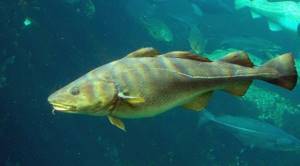
Cod contains a huge amount of vitamins A, D and E, as well as Omega-3
The following type of fish contains huge amounts of vitamins A, D and E, as well as Omega-3. This fish is cod.
The most valuable fish are those classified as freshwater and migratory.
Despite all the usefulness of fish, you should not overeat it, as this may not lead to the results you expect.
Advantages and disadvantages of fried fish and how best to cook it
If you take a certain variety and cook it in two ways, for example, steamed and fried, then in the first case the calorie content will be lower than in the second.
But if you are struggling with excess weight and you prefer fried fish rather than boiled fish, then don’t look at the calories, regardless of them, such a delicacy helps burn fat and helps you become slimmer. During frying, high heat treatment occurs, which destroys all possible parasites present in river fish, so this is not only a tasty, but also a safe method of cooking. You need to be able to properly cook fish in order to preserve beneficial vitamins and microelements in it. The most useful in terms of the amount of substances will be fresh fish. During heat treatment, beneficial substances disintegrate, so in fried food there will be fewer of them than in boiled food. Fish is a unique product, despite the widespread belief that everything fried is harmful to the body, because it has a lot of calories, 100 grams on average 140 Kcal, and this is due to the vegetable oils used in cooking.
How to fry river fish
The best varieties for frying are carp, carp, and bream; the dish from them will turn out juicy, regardless of the cooking method.
First you need to clean the fish from scales, usually this is done with a special knife. Next, wash off the remaining scales with running water, gut the fish, cut off the fins, remove the gills or completely cut off the head, and rinse again. If you don’t like to take the bones out of the fish, there is a little trick - make transverse cuts on the back, so the small bones, of which there are a lot in this part, will not be felt after frying, they will steam and become softer. Rub the fish with salt and pepper and wait 30-50 minutes. Roll in flour and place in a preheated frying pan with plenty of vegetable oil; the fish will taste better if it is unrefined. Fry on both sides until golden brown. Delicious fried fish is ready. Bon appetit!
How to choose the right fish
The freshest fish in stores is sold head on. She has light, transparent and protruding eyes. If the eyes are cloudy and sunken, then the freshness of such fish is suspicious. If the fish has already been lying down, then its head is usually cut off and sold as gutted. This does not mean that the fish is rotten, just “second fresh”.
When choosing fresh frozen fish, all of the above signs no longer matter. In order to check the quality of frozen fish, you need to stick a hot knife into it. If you then smell the knife and an unpleasant odor emanates from it, this indicates that the fish is no longer fresh.
In stores, of course, it is difficult to take such advice. But if the fish’s skin is shiny and the carcass itself is straight, then it’s worth buying.
Fish fillet - pieces removed from skin and bones - is a wonderful fish product. But often there is a thick ice crust on its surface. It occupies up to thirty percent of the weight of the piece. According to standards, such a crust should not exceed ten percent of the weight, so when choosing a fillet, you need to pay attention to its thickness in order to pay less for water.
Why is fish considered a dietary product?
Due to the fact that the fats in fish are fusible and are absorbed much faster than in meat, many nutritionists recommend a “fish and vegetable” diet for “obese” patients. Its duration is 10 days, and during this time you can get rid of at least 3 kg of excess weight. Having understood how many calories are in fish, now it will not be difficult to competently build a menu and approximately determine the calorie content of your favorite dish. For special nutrition aimed at losing weight, it is necessary to use only low-fat varieties, boiled or baked.
Such a diet is not only balanced, but also tasty; fish will not allow you to gain excess weight, but will provide vitality and good mood.
Fish dishes and diets
According to many people, high-fat varieties are too high in calories, so they refuse to consume them, preferring strict diets, unaware of the beneficial effects of fish dishes on health.
The amount of protein and calories contained in fish depends on its type. River fish has much fewer calories than sea fish. The product contains Omega polyunsaturated acids, which burn fat and accelerate blood circulation by reducing lipids. Even for obese people, the calorie content of the richest type of fat is considered negligible.
All fish, regardless of type, have nutritional value and are high in potassium, phosphorus and magnesium. A good example, a close relative of cod, the river burbot, has a liver rich in vitamins B, A, E, D.
This is a product that has high nutritional value and low calorie content, which allows you to live a long time without disease. A fish diet restores blood pressure, prevents the development of atherosclerosis, and lowers cholesterol. It doesn’t matter how many calories there are in fish when you know about its nutritional value, the amount of vitamins and minerals that are present in it.
If you want to lose 3 to 5 kg of weight, then eat fish dishes for 10 days. It is better to use low-fat fish and fry it in a minimum amount of oil. You can eat green vegetables along with it and you need to drink plenty of water.
Eat fish to retain beneficial vitamins and microelements. The most useful in terms of the amount of substances will be fresh fish. During heat treatment, beneficial substances disintegrate, so in fried food there will be fewer of them than in boiled food. Fish is a unique product, despite the widespread belief that everything fried is harmful to the body, because it has a lot of calories, 100 grams on average 140 Kcal, and this is due to the vegetable oils used in cooking.
What's healthy about fish?
The calorie content of fish and the amount of protein in it depend on its type. If you compare river and sea fish, then naturally, sea fish will have much more calories. Salmon, salmon, beluga, stellate sturgeon, herring, and mackerel contain increased amounts of Omega-6 and Omega-3 fatty acids. Oddly enough, it is fish oil that makes the type of fish most nutritious and valuable for the body. Speaking about the calorie content of sea fish, let's say that its indicator is higher than river fish.
Omega polyunsaturated acids have a high level of physiological activity. They take part in intercellular processes, have an anti-inflammatory effect, and are also able to reduce the amount of lipids in the bloodstream. Omega-3 and Omega-6 acids directly affect fat cells, thereby reducing weight. Therefore, the question of how many calories are in fish disappears by itself.
All types of fish, the calories of which are used to count when losing weight, have high nutritional value. They are rich in potassium, phosphorus, magnesium. By eating the liver of cod or other fish, you supply your body with vitamins B, A, E, D. For those who have problems with the thyroid gland, sea fish and seafood should not be removed from the menu, since they are rich in iodine and fluorine. Along with the nutritional value, the calorie content of sea or river fish is considered insignificant not only for people with normal weight, but also for those who are obese.
In order to preserve their health, the Japanese introduced fish and seafood to their national dishes. They believe that by eating meat, the body does not receive the same high-quality protein and energy boost as when eating fish, whose calorie content is much lower. Thanks to fish with its nutritional value, you can live a long time without health problems.
Unsaturated fatty acids regulate blood pressure, prevent the development of atherosclerosis, and reduce cholesterol in the blood. Many vitamins and minerals are found in fatty fish, but those who see the nutritional value of fish will not ask how many calories are hidden in fish.
Calorie table for fish and seafood
As you can see from the table, the calorie content of fish ranges from 70 to 330 kilocalories per 100 grams of product and directly depends on the fat it contains.
Calorie table for fish and seafood:
| Product | Bel, gr. | Fat, gr. | Angle, gr. | Cal, kcal. |
| Fish | 15,0-23,0 | 0,7-16,0 | 0,0 | 70,0-330,0 |
| Salmon | 21,6 | 6,0 | 0,0 | 140,0 |
| Trout | 19,2 | 2,1 | 0,0 | 97,0 |
| Salmon | 19,9 | 13,6 | 0,0 | 201,0 |
| Mackerel | 18,7 | 11,9 | 0,0 | 181,0 |
| Pollock | 15,9 | 0,9 | 0,0 | 72,0 |
| Flounder | 16,5 | 1,8 | 0,0 | 83,0 |
| Cod | 17,7 | 0,7 | 0,0 | 78,0 |
| Tuna | 23,0 | 1,0 | 0,0 | 101,0 |
| Sole | 10,3 | 5,2 | 0,0 | 88,0 |
| Pink salmon | 20,5 | 6,5 | 0,0 | 142,0 |
| Herring | 16,3 | 10,7 | 0,0 | 161,0 |
| Catfish | 19,6 | 5,3 | 0,0 | 126,0 |
| Halibut | 18,9 | 3,0 | 0,0 | 102,0 |
| Dorado | 18,0 | 3,0 | 0,0 | 96,0 |
| Pelengas | 18,0 | 5,0 | 0,0 | 84,0 |
| capelin | 13,4 | 11,5 | 0,0 | 157,0 |
| Mussels | 11,5 | 2,0 | 3,3 | 77,0 |
| Shrimps | 22,0 | 1,0 | 0,0 | 97,0 |
| Squid | 18,0 | 0,3 | 0,0 | 74,0 |
| Red caviar | 31,6 | 13,8 | 0,0 | 250,0 |
| Flying fish roe | 13,0 | 3,1 | 10,0 | 92,0 |
| Pike | 18,4 | 0,8 | 0,0 | 82,0 |
| Acne | 14,5 | 30,5 | 0,0 | 332,0 |
| Sardine | 20,6 | 9,6 | 0,0 | 169,0 |
| Oily fish | 18,8 | 4,2 | 0,0 | 112,0 |
| Hake | 16,6 | 2,2 | 0,0 | 86,0 |
| Dory | 16,8 | 6,0 | 0,0 | 90,0 |
| Haddock | 17,2 | 0,2 | 0,0 | 71,0 |
| Chum salmon | 22,0 | 5,6 | 0,0 | 138,0 |
| Zander | 19,2 | 0,7 | 0,0 | 84,0 |
| Pangasius | 15,0 | 3,0 | 0,0 | 89,0 |
| Carp | 16,0 | 5,3 | 0,0 | 112,0 |
| Macrurus | 13,2 | 0,8 | 0,0 | 60,0 |
| Blue whiting | 16,1 | 0,9 | 0,0 | 72,0 |
| Ice fish | 17,7 | 2,2 | 0,0 | 90,0 |
| Char | 22,4 | 5,7 | 0,0 | 135,0 |
| Hokies | 19,2 | 0,3 | 0,1 | 75,0 |
| Navaga | 16,1 | 4,2 | 1,0 | 73,0 |
| River perch | 18,5 | 0,9 | 0,0 | 82,0 |
| crucian carp | 17,7 | 1,8 | 0,0 | 87,0 |
| Caspian carp | 18,2 | 2,7 | 0,0 | 97,0 |
| Azov carp | 18,4 | 5,3 | 0,0 | 121,0 |
| Whitefish | 19,0 | 7,5 | 0,0 | 144,0 |
| Swordfish | 19,7 | 6,7 | 0,0 | 144,0 |
| tilapia | 20,1 | 1,7 | 0,0 | 96,0 |
| White amur | 18,6 | 5,3 | 0,0 | 134,0 |
| Coho salmon | 21,6 | 6,0 | 0,0 | 140,0 |
| Silver carp | 19,5 | 0,9 | 0,2 | 86,0 |
| Som | 16,8 | 8,5 | 0,0 | 143,0 |
| Notothenia | 15,7 | 9,5 | 0,0 | 148,0 |
| Lakedra | 21,0 | 16,0 | 0,0 | 240,0 |
| Saida | 19,4 | 0,9 | 0,0 | 92,0 |
| Congrio | 19,1 | 1,9 | 0,0 | 94,0 |
| Bream | 17,1 | 4,1 | 0,0 | 105,0 |
| Mullet | 21,0 | 0,4 | 0,0 | 124,0 |
| Asp | 18,8 | 2,6 | 0,0 | 98,0 |
| Loban | 19,3 | 3,8 | 0,0 | 117,0 |
| Muksun | 17,5 | 2,0 | 0,0 | 88,0 |
| Grayling | 17,5 | 2,0 | 0,0 | 88,0 |
| Ide | 18,2 | 1,0 | 0,0 | 81,0 |
| Chekhon | 17,5 | 2,0 | 0,0 | 88,0 |
| Little Red Eye | 21,9 | 4,2 | 0,0 | 125,0 |
| Red salmon | 20,3 | 8,4 | 0,0 | 157,0 |
| Sea bass | 15,3 | 1,5 | 0,0 | 79,0 |
| Sturgeon | 16,4 | 10,9 | 0,0 | 163,0 |
| Sea kale | 0,9 | 0,2 | 0,0 | 5,0 |
For dietary nutrition, it is best to use fresh, steamed or boiled fish. But oil-fried fish and canned fish can easily add extra pounds.
Nutrients in fish and seafood
Eat sea fish more often - this will help maintain youth longer. It contains B vitamins, sodium, potassium and phosphorus, as well as trace elements and fatty acids that have a positive effect on heart function and blood quality.
Seafood is simply necessary to ensure the proper functioning of the body. They contain easily digestible protein, especially a lot of it in lobsters and shrimp, as well as zinc, iron, copper, iodine and phosphorus. This makes them a powerful aphrodisiac. Seafood is low in valuable fats from the omega-3 family. Crustaceans, in turn, have a lot of cholesterol.
